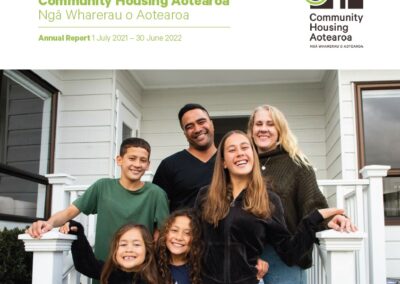 Habitable
Habitable
A step change in the quality of New Zealand housing stock is required. Too much of the existing stock, particularly rental housing stock serving those on the lowest incomes, does not meet objective basic habitability standards. The action required to begin changing this is the implementation of a mandatory, nationwide rental housing Warrant of Fitness. The WoF should set requirements for heating, ventilation and safety. Coupled with this requirement should be incentives for landlords to achieve early compliance, especially where vulnerable tenants are involved.
To further incentivise landlords to comply with the Warrant of Fitness, the use of the Accommodation Supplement rental subsidy should be restricted to homes complying with the WoF standards. The onus for monitoring these regulations should not be on tenants but the appropriate regulatory body.
For new housing stock, a performance-based system can be adopted in the Building Act to ensure homes meet World Health Organisation guidelines for interior tempratures year round.
Affordable
The Crown Land programme can deliver mixed-income, mixed-tenure communities. Government leadership to expand it nationally will significantly increase affordable housing supply. Councils should be encouraged to adopt similar programmes for their surplus land and provided with the tools to implement this. Finally, Government should incentivise private developers to deliver social and affordable homes in their new development schemes. This is a proven model and can be quickly scaled up.
The Social Allocation System can be used as a tool to document all housing need, in addition to its role to access the Social Housing Register. The data received from households requesting housing assistance can be used to identify solutions for families outside the scope of the Income Related Rent subsidy programme. Reviewing and updating the system will provide positive outcomes for many more families.
The Accommodation Supplement is another tool for providing affordability in housing but needs to be reviewed to ensure it meets affordability thresholds across the country.
Innovative programmes which provide new ways of supporting families to access and sustain homes should be nurtured. The Housing First programme is an example where Government is applying a proven evidence-based model to ending homelessness. This programme can be expanded nationwide to deliver benefits to the homeless and the taxpayer.
Accessible
The barriers to accessing adequate housing need to be identified and removed. As discussed in Affordability, the Social Allocation System can be used as a tool and needs to be reviewed and updated to make housing accessible for many more families.
To help achieve physical accessibility, Universal Design principles can future proof Kiwi homes to meet the needs of an aging population. This is best achieved at the scale required by adopting Universal Design principles into the Building Act so they become business as usual. As this will take time to deliver, tools and resources to modify existing homes can be developed to meet current accessibility requirements.
A housing plan should be required for all persons being discharged from state care. No-one should leave a hospital, or youth exit foster care, or a state house tenant be evicted, without an identified new home for them to stay that night. The most effective response to reducing homelessness is to prevent it in the first instance.
Security of tenure
The documented change of tenure from predominately home owner to rental warrants a strengthening of tenant protection in the Residential Tenancies Act. These protections can be further safeguarded by resourcing independent tenant advocacy organisations to assist tenants to understand and assert their rights. Longer term leases providing greater security of tenure can be drafted for adoption by landlords and renters. Requiring these for use in Crown subsidised homes would speed up the change process.
As home ownership provides the greatest security of tenure, increased home ownership incentives and programmes should be encouraged. Existing programmes including Welcome Home loans, Kāinga Whenua loans, the KiwiSaver HomeStart grant scheme, and similar, are great building blocks for inceasing home ownership. Innovative new programmes should be encouraged.
Culturally Appropriate
More homes meeting the needs of non-Pakeha New Zealanders are required. Supporting organisations to design and build homes to meet the diverse cultural backgrounds of New Zealanders will help address the imbalance. The existing Māori Housing Network and Māori Housing Strategy provide a platform to meet the needs for Māori. Similar initiatives for Pacific peoples and other ethnicities present opportunities to address the needs of other cultural groups.
For these efforts to be successful, regulatory barriers must be removed. For example, the Kāinga Whenua loan programme can deliver more homes if barriers to developing multiply owned land are addressed.


